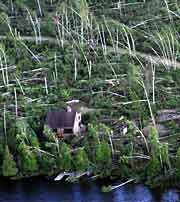By Bob Kelleher
Minnesota Public Radio
May 3, 2002
Researchers are finding that young trees are growing quickly in the massive timber blowdown in the Boundary Waters Canoe Area Wilderness. But they're surprised by some of the tree species that are springing up in the wake of the storm three years ago. When regrown, parts of the former pine wilderness may resemble hardwood forests to the south - and some say global warming just might be the reason.
| |
|
|
|
||
The picture is as familiar as the old Hamm's Beer commercials - clear, blue, island-studded lakes, surrounded by lush stands of tall white and red pine trees, generously spiked with white aspen.
But in the future those Boundary Waters trees could be well be stunning red maples and burly oaks. The experts say they are seeing changes in the blowdown area.
The July 4, 1999, storm was not what you'd expect in cool northeastern Minnesota. It was huge - filled with energy generated by a potent mix of humidity and hot weather.
At the National Weather Service office in Duluth, head meteorologist Michael Stewart says he has seen lots of severe weather, but the July 4 storm was extraordinary. He says it was one of the bigger, and most ferocious storms he's seen in his career.
"This storm already had a history of 90 to 100 mph winds," he says. "I knew that this storm was going to be bad."
It was. Century-old pine trees just snapped in the storm. Some 400,000 acres of trees were simply flattened. Was the storm a harbinger of global warming?
Stewart thinks the storm might have been an extreme manifestation of normal weather. He notes the region's winters five and six years ago, with record snows and record cold. But, he says, the last four winters have been reasonably mild.
|
"There is a hypothesis that these big blowdowns in the northern forest are a result of global warming. Previously, they occurred down in the prairies of Kansas and Iowa, and now they're occurring further to the north."
- U of M forestry expert Lee Frehlich |
Take this past winter, he says. "We lost our snowpack in January, which is unheard of in the Northland."
But what's growing back in the blowdown raises questions. University of Minnesota forestry expert Lee Frelich is surprised how quickly trees and brush have emerged. Frelich has been monitoring regrowth across the blowdown. He says some saplings are springing a foot or more each season. And many of those saplings are hardwoods.
"There's a lot more red maple there than we would have thought that was in the understory," says Frelich. "Now, red maple is near the northern edge of its range right there. We really didn't expect to have that much red maple, especially in the eastern edge of the Boundary Waters, near the Gunflint Trail."
Bur oak seedlings can be found all over the forest floor in what had been a 300-year old red and white pine forest. Both the oak and maples are common to the south, like in Michigan's Upper Peninsula.
Both stand up well to storms, and both enjoy a warmer climate.
"It probably indicates that the climate is a little warmer. Red maple will freeze in the winter, and the trunk will crack if it gets very, very cold," Frelich says. "For far northern Minnesota, it's mainly the winter temperatures that are far warmer than they were a few decades ago."
The 1999 storm was the fourth regional blowdown in recent years. Frelich says some wonder whether global warming is to blame.
| |
|
|
|
||
"There is a hypothesis that these big blowdowns in the northern forest are a result of global warming. Previously, they occurred down in the prairies of Kansas and Iowa, and now they're occurring further to the north," he says.
But Frehlich says more research is needed. He says there's a need to get more data, to examine whether the frequent violent storms are a result of a weather fluctuation or part of a long-term trend.
Another surprise is the spread of dogwood throughout the blowdown. The leafy brush was thought a wetland species. It is known to retain moisture in its shade, which speeds the rot of damaged timber.
Still, the danger of catastrophic fire remains very high - especially if the area suffers a prolonged dry spell.
Chris Reichenbach of the U.S. Forest service office in Duluth, says Boundary Waters visitors should expect strict campfire restrictions again this summer.
While fire seems unlikely at this time of year, Reichenbach warns, "It may not take very much for a fire to get started."
Outdoor burning restrictions are now in place across Minnesota. They'll remain in place until green-up, which in northern Minnesota, may be several weeks away.
More from MPR

